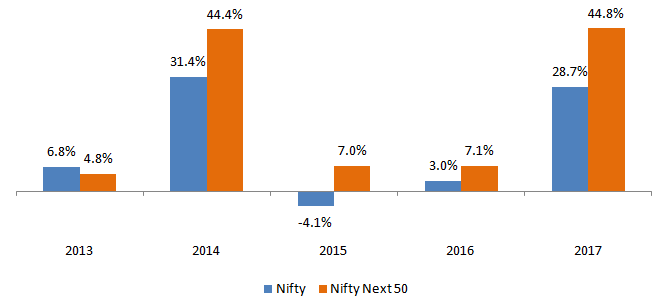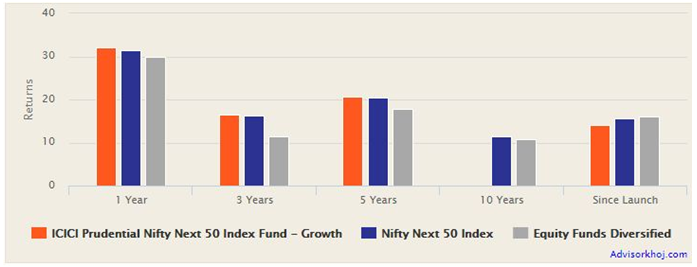ICICI Prudential Nifty Next 50 Index Fund: Top returns in the last 3 years

In 2007 legendary investor Warren Buffet made a million dollar wager against a hedge fund manager that a simple S&P 500 index fund would outperform a selection of actively managed funds over a 10 year period. The bet’s time line started on January 2008 and ended in January 2018. Warren Buffet won the million dollar bet, as the index fund beat the actively managed funds by a huge margin. Buffet’s bet is conclusive evidence of what many studies had shown earlier that, actively managed funds would struggle to beat the S&P 500 index consistently over a long period of time.
One of my old school friends, a big fan of Warren Buffet, asked me recently why is there little coverage of index funds in our Advisorkhoj blog. I believe that our stock market is not as mature as the US stock market and there are inefficiencies which fund managers can exploit to generate alphas for investors. In order to test my hypothesis, let us re-enact Warren Buffet’s bet in India. Suppose we had Rs 100,000 to invest in January 2008. One option was to invest in Sensex and the other option was to invest in a portfolio of actively managed funds. I looked at the 2007 returns of the large cap equity funds from the 15 largest AMCs and selected the 5 top performing funds for investing Rs 20,000 in each fund. For purpose of this analysis, I did not change the fund selection for the next 10 years, even though I may have been disappointed with the returns of some of the funds in my portfolio. Let us now see the results in the chart below.

Source: Advisorkhoj Research
You can see that, my MF portfolio was able to beat the Sensex. No credit to me of course, the credit goes entirely to fund managers who were able to generate alphas to beat the index. However, I cannot say with confidence that, actively managed funds will be able to beat the Sensex for the next 20 years. As our market becomes more efficient over time, opportunities of generating sufficiently large alphas will reduce and index funds will become increasingly popular in India as well.
In fact, ICICI Prudential Nifty Next 50 Index Fund is one of the top performing diversified equity funds in terms of 3 year trailing returns (please see Top Performing Mutual Funds (Trailing returns) - Equity Funds Diversified). Before we discuss different aspects of this fund’s performance, let us discuss what index funds are.
Index Funds
Index funds are mutual fund schemes which track an index. The portfolio composition of index funds replicates the benchmark index; the holdings are exactly in the same proportion as the index. Unlike actively managed funds, index funds do not aim to beat the index. The objective of index funds is to reduce tracking errors to a minimum and match index returns as closely as possible (we will discuss tracking errors in more details later in this post).
The biggest advantage of index funds is in their expense ratios. The expense ratio of ICICI Prudential Nifty Next 50 index fund – Regular Plan is only 0.81% (that of Direct Plan is only 0.42%). Expense ratios of actively managed diversified equity funds can be 2.5% or even higher. The expense ratio comes out of the returns of the fund. So if an actively managed fund is not able generate sufficiently large alphas, then over a long period of time the impact of expense ratio can be substantial.
Most index funds have very short term exit loads, e.g. no exit load after 7 days from the date of investment. Very short term exit load, however, in our opinion should not encourage trading behavior on part of investors because it can lead to losses in the future. In our view, investors should invest in index funds with a sufficiently long investment horizon (at least 3 years) because equity as an asset class is volatile in nature and gives superior returns over long investment tenures. Nevertheless, the very short term exit load is an advantage, if you suddenly need liquidity for any unforeseen reason.
Contrary to normal assumption that all unsystematic risks are diversified in a mutual fund, the risk of a fund is not exactly the same as the benchmark index because the fund manager may be overweight or underweight on certain stocks to generate alpha – this risk can be called the fund manager risk. Index funds are exposed to market risk only because their portfolio composition replicated the benchmark market index. This can be an advantage or disadvantage depending on whether or not the investor wants to take more than market risk to get better returns.
Though Nifty and Sensex are the two major indices in India, there are several other indices like Nifty Next 50, BSE 100, Nifty 100, Bank Nifty etc. Some of these indices may outperform the headline indices (Nifty or Sensex) over certain periods. Index funds track different indices and investors can select index funds based on which index / sector they would like to invest. Let us now discuss Nifty Next 50 index.
Nifty Next 50 Index
Nifty 50 was launched in 1996 and is one of the 2 major stock indices in India, the other being the BSE Sensex. Nifty is the index of the 50 largest companies by market capitalization in India. Nifty 50 is a free float market capitalization weighted index, i.e. its components (companies) are weighted according to the market value of their outstanding shares. In a free float market capitalization index, only the market value of free float shares (shares held by general public) are taken into account. Nifty 50 represents 65% of market capitalization of all stocks listed on the National Stock Exchange (NSE).
Nifty Next 50 index was launched in January 2007 and represents 50 companies among the 100 largest companies by market cap in India, after excluding the Nifty 50 companies. In other words, the Nifty Next 50 index comprises of the 51st to 100th largest companies by market cap. Like Nifty 50, Nifty 50 is also a free float market capitalization index. Nifty Next 50 represents about 12% of market capitalization of all stocks listed on the NSE.
Nifty Next 50 Index has outperformed Nifty by a fairly big margin over the last 5 years (please see the chart below).

Source: Advisorkhoj Research
Regular Advisorkhoj readers will notice that our review of ICICI Prudential Nifty Next 50 Index Fund is different from our usual fund reviews. The reason is twofold. Firstly, index funds are not very popular in our country and there is little awareness of these funds among retail investors. We want to educate investors about this type of funds. Secondly, unlike actively managed diversified equity funds, index funds are passively managed. So when you are investing in index funds, you are essentially investing in a stock market index; therefore, it is imperative that you understand the relevant index well before investing. We will revisit the Nifty Next 50 Index again later in this post, but let us now give a brief overview of ICICI Prudential Nifty Next 50 Fund.
Fund Overview
ICICI Prudential Nifty Next 50 Fund was launched in June 2010. The fund has Rs 157 Crores of assets under management (AUM). There is no exit load after 7 days from date of investment – redemptions within 7 days from date of investment will attract an exit load of 0.25%. The chart below shows the trailing returns of ICICI Prudential Nifty Next 50 Fund versus the benchmark and diversified equity funds category over various time scales.
ICICI Prudential Nifty Next 50 Index Fund – Growth option gave 30.7%, 16.43% and 20.48% annualized returns in the last 1, 3 and 5 years compared to 29.86%, 16.26% and 20..33% by NIFTY 50 Index and 29.12%, 11.54% and 17.57% by the diversified equity fund category respectively in the last 1, 3 and 5 years. (Source: Advisorkhoj – Data as on January 30, 2018)

Source: Advisorkhoj Research
You can see that fund and the index both outperformed the fund category over the last 1, 3 and 5 years. Further observe that, returns of the fund and the index are almost the same over the last 3 and 5 years; so the tracking error is very low. This is the hallmark of a good index fund. The chart below shows the annual returns of ICICI Prudential Nifty Next 50 Index Fund versus the benchmark and category over the last 5 years.

Source: Advisorkhoj Research
You can see that the fund outperformed the diversified equity funds category in most years. This may surprise some of our readers because ICICI Prudential Nifty Next 50 Index Fund invests only in Nifty 100 companies (100 largest companies by market cap in India). As per recent SEBI guidelines to AMCs, 100 largest companies by market cap in India are to be classified as large cap companies. Actively managed diversified equity funds, on the other hand, are likely to have investments in midcap companies as well. The outperformance of ICICI Prudential Nifty Next 50 Index Fund in years when midcap stocks were having a dream run may be contrary to normal expectations, but it shows that investors and financial advisors need to go a little deeper in MF research and not base investments on generally accepted beliefs.
Tracking Error
As discussed earlier, tracking error is the most important metric of an index fund because when you are investing in an index fund, you are not investing in the fund manager’s ability, you are simply investing in the index. The theoretical definition of tracking error is the standard deviation of excess returns of the fund over the benchmark. However, the simpler definition is the difference of returns of the fund and the benchmark. I prefer to work with the simpler definition, particularly if the complicated definition does not enhance my understanding in any significant way, but if you are interested in standard deviations, do write to us and we will explain how to calculate it. The chart below shows the tracking errors of ICICI Prudential Nifty Next 50 Index Fund versus the index.
![]()
Source: Advisorkhoj Research
Before we get into the tracking errors of ICICI Prudential Nifty Next 50 Index Fund, let us discuss what gives rise to tracking errors because you may be wondering that, if the fund is simply replicating the index, buying stocks in exactly the same proportion as the index, then why should there be any tracking error.
There are three main reasons for tracking errors in an index fund. Firstly, the index is simply the market cap weighted value of its constituents but an index fund has got expenses. These expenses, however small, will have an impact on returns. Secondly, any fund at a given amount of time will have some cash in its portfolio waiting to be deployed in stocks. The delay in allocating funds mobilized from investors to stocks will give rise to tracking errors. Thirdly, a large transaction (buy or sell) by the index fund may impact stock prices and therefore, market cap weights of the index. Tracking error can be reduced by how well the index fund manages fresh subscriptions and redemptions.
What is acceptable tracking error? Historically, in our market, +/- 1 to 2% tracking errors were considered acceptable. You can see in the chart above that, the tracking error of ICICI Prudential Nifty Next 50 Fund never exceeded +/- 1%. We think this is good index fund management.
Conclusion
ICICI Prudential Nifty Next 50 Index Fund is open for subscription. You can invest in both lump sum (minimum subscription amount of Rs 5,000 and minimum additional purchase amount of Rs 1,000) and through systematic investment plan. You can also invest through systematic transfer plan from another mutual fund scheme. The fund has delivered strong performance over the last 3 years outperforming most actively managed diversified equity funds. Investment experts say that, investors should have index funds along with actively managed mutual funds in their long term investment portfolios to get superior risk adjusted portfolio returns. Investors should consult with their financial advisors if, ICICI Prudential Nifty Next 50 Index Fund is suitable for their investment needs.
Mutual Fund Investments are subject to market risk, read all scheme related documents carefully.
Queries
-
What is the benefit of mutual fund STP
Aug 29, 2019
-
How much to invest to meet target amount of Rs 2 Crores
Aug 26, 2019
-
Can I achieve my financial goals with my current mutual fund investments
Aug 24, 2019
-
Can you tell me return of various indices
Aug 19, 2019
-
What would be the post tax return on different investments
Aug 18, 2019
-
Which Principal Mutual Fund scheme will be suitable for my retirement corpus
Aug 16, 2019
-
What is the minimum holding period for availing NCD interest
Aug 4, 2019
Top Performing Mutual Funds
Recommended Reading
Fund News
-
Zerodha Mutual Fund launches Zerodha Nifty Short Duration G Sec Index Fund
Dec 26, 2025 by Advisorkhoj Team
-
Groww Mutual Fund launches Groww Nifty Chemicals ETF
Dec 26, 2025 by Advisorkhoj Team
-
DSP Mutual Fund launches DSP Nifty Next 50 ETF
Dec 19, 2025 by Advisorkhoj Team
-
DSP Mutual Fund launches DSP Nifty 500 Index Fund
Dec 19, 2025 by Advisorkhoj Team
-
Kotak Mahindra Mutual Fund launches Kotak Nifty Next 50 ETF
Dec 18, 2025 by Advisorkhoj Team














